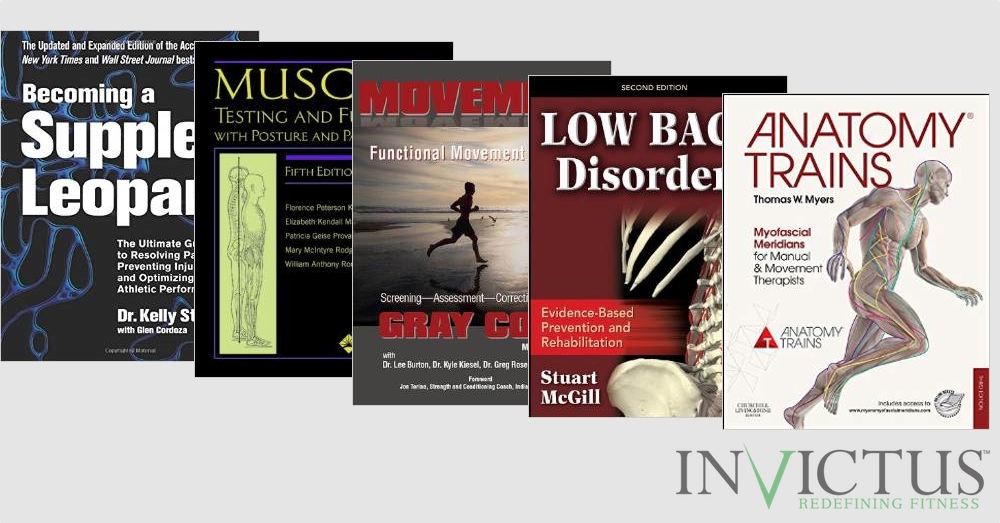
5 Mobility Books Every Coach Should Read
Written by Calvin Sun
(Originally published on May 26, 2015)
“The book you don’t read won’t help.” – Jim Rohn
Trying to be a high-performance CrossFit athlete with poor mobility is like trying to drive a race car with square wheels. You can do it, but as you can imagine, that car is not going perform optimally or last you very long. I get asked all the time by coaches, athletes, and clients for book recommendations on mobility, movement screening, and corrective exercise. While there are many books I could recommend, I figured it might be helpful for me to narrow down the list to some of the best:
Now in its second edition, Kelly Starrett’s book is a solid reference guide for any coach or athlete who wants some tips and ideas for mobility drills. The book is divided into sections that allow you to skip around and jump straight to becoming a supple leopard. However, I’d still recommend reading it from start to finish or you may get a little lost. The core concepts taught by Starrett are centered around “smashing” and “mobilization”. There isn’t quite as much information on causation, so you may want to read one of the other books I recommend to avoid a lot of trial and error when troubleshooting an issue. That being said, if you’re looking for an encyclopedia of stretching and myofascial release drills, it’s hard to find a better book.
2. Anatomy Trains: Myofascial Meridians for Manual and Movement Therapists by Thomas W. Myers
Most anatomy books tend to compartmentalize the body into pieces. The biceps are an elbow flexor, the quadriceps are a knee extensor, blah blah blah. The body doesn’t function in a compartmentalized, isolated manner. The human body is an entire interconnected and interdependent system that produces movement in the most incredible ways. Myers’ book eloquently explains and illustrates the anatomy of movement. This is a must-have for any coach who really wants to be able to effectively apply the tools and techniques they learn from other experts.
If you want to learn assessment tools, like screening tests for tight lats or hip flexors, then check out this classic text by Kendall. The book is a deep dive into all things related to assessment and posture. Don’t understand what muscles are elongated and weak compared to which ones are strong and short in sway-back versus flat-back postures? Don’t know what the normal range of motion should be for the ankle? You’ll learn all of that and more in this book. It’s another must-have text that should belong in the library of any serious coach.
4. Movement: Functional Movement Systems: Screening, Assessment, Corrective Strategies by Gray Cook
Gray Cook is a world-class physical therapist and probably best known as the creator of the Functional Movement Screen. One of his key principles is that strength should not be built on top of dysfunction. Contrary to what some novice coaches may believe, trying to get strong with a dysfunctional pattern means the dysfunction only gets worse. From a performance standpoint, dysfunctional movement is inefficient and robs you of achieving your genetic potential. From a prevention standpoint, dysfunctional movement is more likely to result in pain and injury (which seems kind of obvious but people do it anyway). In this book, Cook goes into screening, assessment, as well as strategies to improve the quality of movement in an athlete. I highly recommend this book for anyone who works with athletes and wants to help improve their performance as well as prevent injury.
5. Low Back Disorders, Second Edition by Stuart McGill
Dr. Stuart McGill is considered one of the top spine biomechanists in the world. He’s worked with professional athletes ranging from world-champion MMA fighters to elite powerlifters. I have found that Dr. McGill’s knowledge is equally applicable to CrossFit athletes. His work is primarily centered around training the midline for optimal stability and preventing back injury. I include this book on my list because back issues are quite prevalent in all populations ranging from career desk-jockeys to competitive athletes. The exercise recommendations in the book are grounded in a thorough amount of scientific research. You’ll learn about which commonly prescribed gym exercises are actually really bad for your back and spine health as well as safer and more effective alternatives. I highly recommend this book if you or anyone you work with might have back issues.
If I were to teach a course in mobility, movement, and corrective strategies to fitness coaches, these would be the textbooks I would require my students to read. While certainly not everything you’ll ever need to know, studying (and applying) the knowledge in these particular books will give you a very solid foundation in the principles, methods, and technical aspects of mobility, movement, and corrective exercise.
Do you have a favorite mobility book? Please share your recommendations!
This is very important for us to read today.
Hi, let’s say I want one book. Which one do you recommend most? thanks!